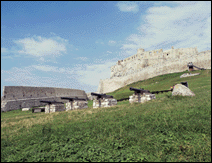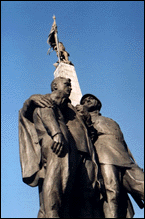 HISTORY HISTORY |
Regnum nostrum,Domine, gratia tua respice. Et
ne tradas nostra alienis nec nos convertas in praedam
populorum paganorum. Old Slovak liturgical prayer

Favorable natural conditions on the territory opened to the south had attracted people from time long forgotten. A cast of the Neanderthal man's skull was found in Ganovce in the Northeastern Slovakia and a skull of a Neanderthal woman was discovered in the deposits of the Vah River.
Numerous archaeological finds, settlements and various artifacts document the checkered history of the Slovak territory during the Stone Age. Later, in the Bronze Age, current Slovak territory was an important crossroads for different ethnical groups and tribes, mainly the Celts, the Romans and Germanic tribes. West-Slavic tribes arrived in the West-Carpathians and adjacent lowlands during the 5th and 6th centuries. Shortly afterwards the Western Slavs established their first state-like formation after their victory over the nomadic tribe of Avars. A Frankish merchant named Samo led Slavic warriors. He became their king until his death in 658.
At the end of the 8th century, two powerful Slavic rulers founded their principalities on the current Slovak territory and neighboring areas. Pribina ruled the Principality of contemporary Nitra and Mojmir ruled the Moravian principality. In the period between 813 and 833 AD, these two principalities merged together under dramatic circumstances thus laying the foundation of the Great Moravian Empire, which at that time were the main rival and ally of the Franki Empire.
Following the invitation of the King Rastislav, two Byzantine missionaries - brothers Constantinus and Methodius - came to his court in 863 AD. In order to make the Holy Bible understandable to the Old Slovak people, they conceived and developed a written form of the Slavonic language. By this act of true genius, Slavonic language became one of the first languages in the world that also possessed a written form. For a short period of time the pope regarded Slavonic as a liturgical language along with Latin, Greek and Hebrew. This official recognition encouraged the beginning of Slavonic writings. Up until now, the Slovak language has preserved many common words, roots and sounds with the Common Slavonic, from which all-Slavonic languages developed.
In the 10th century nomadic tribes of Finno-Ugric Magyars, coming from the eastern slopes of Ural attacked The Great Moravian Empire. After the defeat of the Moravian armies at Bratislava, Slovakia became a part of the multinational feudal Hungarian State. Fortunately, the Magyars soon converted to Christianity. Saint Stephan One of the first Hungarian kings, had both Slovak and Magyar roots and in a successful attempt to avoid rivalry between the two nations he established neither Magyar nor Slovak but Latin as the official Hungarian language. This model worked well for several centuries, when the two nations worked together through times of both hardship and intensive development.
In 1241, Tatars invaded the Hungarian Kingdom, which had a devastating effect on the local population that fled to surrounding mountains. There were many hideouts in the mountains at that time such as Klastorisko (Lapis refugii). The C14th and C15th brought a rapid development of mining towns on Slovak territory. Banska Stiavnica, Kremnica, Banska Bystrica and several others were famous worldwide for their gold, silver and copper mining. In 1526, the Turks defeated the Hungarians at the Battle of Mohacs. A large part of the Hungarian Kingdom fell under the Ottoman control, but Slovakia and the remaining parts of Hungary came under the control of the Habsburg dynasty. Slovakia became the center of Hungarian culture and politics and Bratislava served as the Habsburgs' capital.
Lightning flashes over the Tatras, the thunder pounds wildly, let us stop them, brothers, they will certainly disappear, and the Slovaks will revive...
Slovak anthem, 1st verse
In the revolutionary period of 1848-49 and later
the Slovaks strongly opposed the idea of only one
constituting nation in the Hungarian part of the
Austro-Hungarian Monarchy. Nonetheless, this idea
became popular with the influential Magyar political
elite. Particularly at that time, Slovaks were pressed
to give up their language and cultural identity
and "become Magyars". This dramatic period
of the mutual coexistence ended after the World
War I. Slovak people became one of the constituents
of the modern Czechoslovakia. In this state, they
were able to use their language freely, establish
schools and universities and fulfil some of their
ambitions as a nation. |
However, the treaty signed by Hitler, Chamberlain, Daladier and Mussolini in 1939 in Munich brought about the breakdown of the Czechoslovak Republic. After a turbulent political turmoil and facing the threat of being divided between Germany, Hungary and Poland, Slovakia declared its independence. Thus, the 1st Slovak State was established, loosing significant parts of its territory to Hungary and Poland. The state was immediately recognized by many countries but came under Hitler's heavy political influence and dictate in several matters. As a result of that, about 50,000 Jews were sent to concentration camps, even though Slovak political representatives at those times claimed they did not know that Jews had been murdered in Osviencim, Treblinka and other camps. This could be well considered true at least at the beginning of the deportations. Despite that, the representatives of the modern Slovak Republic and the general public have considered the deportations of Jews the worst smear on the history of the 1st Slovak State as well. It was also one of the reasons why a strong underground movement started the Slovak National Uprising in August 1944. It was the one of the largest insurrection in the Nazi-occupied Europe, second only to Tito's movement in Yugoslavia and aimed at reestablishing the lost Slovak sovereignty. Event though it was suppressed by Wehrmacht after several months, it strengthened the Slovak ambitions to be recognized as a nation in the rearranged Europe.
...This Slovakia of ours has been fast asleep until now, but the thunder and lightning are encouraging it to come alive.
Slovak anthem, 2nd verse
These intentions could not be realized because of a strong centralism by which the new government ruled in the newly restored Czechoslovakia. First the president of the 1st Slovak State, Dr. Tiso was hanged. Then the representatives of the Democratic Party who won the last free elections held in Slovakia in 1948 were unjustly accused of treason by the communists. The Communist Party won the elections in the Czech Republic only and - ironically - even several Slovak communists, among them Dr. Gustav Husak and Dr. Vladimir Clementis, were sentenced to death or long term imprisonment as so called nationalists. All these happenings were completely in line with the scenario imposed by the Soviet Union on the countries that fell under its control after the World War II.

After 20 years of totalitarian communist control, the Prague Spring began well before 1968. It was initiated by a large reform - oriented and influential group within the Communist Party, led by one of the most prominent Slovak politicians, Mr. Alexander Dubcek. Their efforts to create "socialism with a human face" were warmly welcomed practically in the whole society, including churches and former political prisoners. However, in August 1968, the movement was crushed as the Soviet Army invaded Czechoslovakia along with the Polish, East-German and Hungarian armies, complying with the policy of the Warsaw Pact proclaiming the need to protect socialism by all necessary means should it be threatened in any socialist country. The only fruit that remained from the reform period was the declaration proclaiming the Czechoslovak Federation of two republics - Czech and Slovak.
By this act, Slovakia gained more independence in certain matters, such as culture and education. 20 years on, a revolt against the communist rule swept over Czechoslovakia and the communist government was forced to resign in 1989.
Fortunately, this all happened under more favorable international political conditions and therefore the reforms and transition to a democratic political system and market economy have been underway for more than ten years till now. The result of that is that Slovakia - as a independent state from 1993 - has been invited to start negotiations on the EU accession as soon as February 2000, with the perspective of joining the Community in 2004.
Students of Bratislava's Evangelical Grammar School wrote the Slovak national anthem "Lightning over the Tatras" in 1884 during a trip to Levoca in support of Ludovit Stur (a famous Slovak patriot and thinker who codified the Slovak language). The words were set to the Slovak folk song "A girl dig out a well" by Janko Matuska. Based on a popular melody and written in standard Slovak, it became known across the nation and was adopted by the Slovak volunteers of 1848, who printed it as a pamphlet. In December 1918 the first stanza became part of the national anthem of the Czechoslovak Republic and since 1st January 1993 the first two stanzas have constituted the national anthem of the independent Slovak Republic |

